
Theme Parks: Out-of-the-Ordinary Worlds
What Is a "Theme Park"?
Do you like amusement parks? In Japan there are a total of 233 amusement parks,
large and small. The most popular is Tokyo Disney Resort. The "theme" of Tokyo
Disney Resort is Mickey Mouse, Minnie Mouse, and other Walt Disney world characters.
Theme parks like Tokyo Disney Resort are leisure facilities with entertainment
attractions and spaces organized around a particular theme.
Among Japan's
amusement parks are 52 theme parks. Theme park attendance in 2004 totaled approximately
58.92 million with sales of 438.2 billion yen, figures far larger than those
for other amusement parks, zoos, aquariums, and other leisure facilities. Theme
parks are a favorite destination for family trips. According to the JTB travel
agency's Ryokosha doko [Tourist Trends], "theme parks" rank first as the domestic
site families with children wanted most to visit in 2004. For many Japanese,
who find it difficult to take long vacations even if they want to take a break
from their regular routines, theme parks are an ideal place to experience the
atmosphere of earlier eras, relax in natural surroundings, get a taste of the
culture of a foreign country, or meet Mickey Mouse or other dream-inspiring
characters. There, they can relax in an out-oftheordinary world without traveling
great distances.
| No. of facilities | Attendance | Sale (¥) | |
|---|---|---|---|
| Theme parks | 52 | 58.92 million | 438.2 billion |
| Amusement parks | 115 | 28.92 million | 122.0 billion |
| Zoos | 27 | 11.62 million | 15.2 billion |
| Aquariums | 9 | 2.45 million | 9.8 billion |
History
The Museum Meiji-mura in Aichi prefecture (opened in 1965) and Kyoto Studio
Park (1975) are said to be the theme park pioneers of Japan. The English term
"theme park" did not become widely known, however, until Tokyo Disneyland was
opened in Urayasu, Chiba prefecture in 1983. The success of Tokyo Disneyland
led immediately to the building of a succession of theme parks of various kinds
throughout the country. The main factors sustaining this phenomenon include:some
reduction in working hours, allowing people more leisure time; enactment of
the "Resort Law" (Law for Development of Comprehensive Resort Areas), encouraging
the construction of resort facilities providing overnight lodgings; and increase
in disposable income at the time of the bubble economic boom. Also, as theme
parks were expected to provide job opportunities and stimulate the economy
of local areas, many prefectural governments opened them as a means of promoting
local development. Since the collapse of the bubble economy at the beginning
of the 1990s, however, a large number of theme parks have been forced to close
due to poor business.
Despite the ups and downs of the economy,
Tokyo Disney Resort has made huge additional investments and its business has
been supported by many repeat visitors. It now counts more than 25 million visitors
annually. Other theme parks have made various innovations, such as adding a museum
to their facilities and providing participatory entertainments so that visitors
can enjoy themselves in various ways. Some attract more visitors by making
entrance charges free or very low. Others encourage visitors to spend more
time in the park with various rides and attractions and seek to increase the
sales ratio of food and drink, character goods, and the like.
| 1 | Tokyo Disney Resort (Tokyo Disneyland and Tokyo DisneySea) | 25,021,000 |
|---|---|---|
| 2 | Universal Studios Japan | 8,100,000 |
| 3 | Kobe Sweets Harbor (food theme park) | 3,000,000 |
| 4 | Namco Namja Town (including the Ikebukuro Gyoza Stadium that houses gyoza shops from across Japan and China) | 2,512,833 |
| 5 | Huis Ten Bosch | 2,020,000 |
| 6 | Parque España | 1,804,000 |
| 7 | Space World | 1,650,000 |
| 8 | New Reoma World (including Toy Kingdom) | 1,600,000 |
| 9 | Yokohama Curry Museum | 1,520,000 |
| 10 | Spa Resort Hawaiians | 1,457,630 |
Major Theme Parks
Period Themes
Period theme parks include those featuring the Edo (1603-1867), Meiji (1868-1912), Taisho (1912-1926), or Showa (1926-1989) historical eras. Preserving or reconstructing historically valuable artifacts, structures, and even townscapes, these parks not only transmit the wisdom and culture of earlier eras with museumlike exhibits but incorporate various innovative facilities for enjoying the "good old days" atmosphere of bygone times.
Nikko Edo Village
Nikko Edo Village is a theme park opened in Tochigi prefecture in 1986 that offers a comprehensive experience of Edo-period culture and lifestyles. A townscape from the mid-Edo period is reconstructed within the park, and among the attractions are live ninja performances and Edo festival parades. Recently, some TV commercials have featured the village's trademark character Nyan-mage (a cat with a samurai-style topknot).
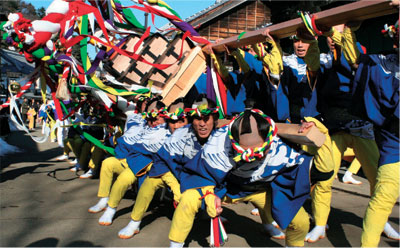
(c) Nikko Edomura
Countries and Cultures of the World
The theme parks featuring specific countries and cultures include those introducing the Netherlands and Spain --shown here-- as well as Denmark and New Zealand. There is also a medieval European port town, a U.S. town of the pioneer-era West, and so on. Most of them take up countries that have images in Japan of attractive or lively scenery and relaxed atmosphere, making the parks places where visitors can get away from the stress and bustle of daily life and find enjoyment and refreshment of the spirit. Another characteristic of these parks is their selection of a country and culture that has some connection to or affinity with the local landscape and heritage.
Huis Ten Bosch
Located in Nagasaki prefecture, this theme park is a 152-hectare resort equipped
with overnight lodgings. It is modeled on a townscape in the Netherlands, a
country with which Nagasaki had close relations during the early modern era
when Japan isolated itself from relations with most other countries. "Huis
Ten Bosch" means "houses of the forest" in Dutch. The park is so named because
it includes a reproduction of the Huis Ten Bosch palace, the official residence
of Netherlands's Queen Beatrix. Today, the park features attractions not only
related to the Netherlands but other parts of Europe as well.
Taking as its
inspiration the wisdom of the Dutch accumulated over 400 years of coexistence
and harmony with nature through reclamation and water-control works, the motto
of the Huis Ten Bosch theme park is "Coexistence of Humanity and Nature." In
building the theme park, careful consideration was given to the environment:
improving the soil of land reclaimed some twenty years previously for use as
an industrial park and construction of embankments using natural stones and
earth to better protect the local ecosystem.
The park is home to 400,000 trees
and 300,000 flowering plants. Since autumn 2005 aiming to become the "world's
top flower resort," it has opened a large flower piazza called "Art Garden" and
held a variety of annual flower-related events. By developing landscaping in
the tradition treasured in Europe, it seeks to be a leader of flower culture
and business with tulip-, rose- and dahlia-growing as its base.
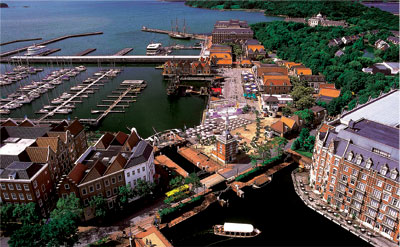
(c) HUIS TEN BOSCH
Parque España
This theme park forms the core of the Shima Spain Village resort facility
developed by the Kintetsu Corporation railway company with the cooperation
of the Mie prefectural and Shima city governments. The village was opened in
1994 at a time when society was making a shift from the overheated "economy
first" era to a time stressing leisure and relaxation after the bursting
of the bubble. With its catchphrase, "Rediscover relaxation and fun," the
park was designed to envelope visitors in the relaxing Spanish-style milieu
--dazzling sun, deep blue seas, fertile land, etc. Its location is in the Ise-Shima
district of Mie prefecture, where pilgrims from all over the country come to
visit Ise Shrine.* Northern Spain, too, has a wellknown pilgrimage site called
Santiago de Compostela, and this similarity --that both are age-old pilgrimage
centers-- is cited as one of the reasons Spain was chosen for the theme park.
Parque España,
which literally means "Spanish park," consists of four areas, including townscapes
modeled after architecture of various parts of Spain, as well as attractions
such as bullfighting and performances of flamenco. There also are shows and
parades given by Spanish performers.
* Ise Shrine: A major Shinto shrine situated in the city of Ise, Mie prefecture. In the eighteenth and nineteenth centuries it was a place people longed to visit at least once in their lifetime, and pilgrimages to the shrine were organized throughout the country.
Motion Pictures
There also are parks with motion pictures as their theme. The major ones are Kyoto Studio Park and Universal Studios Japan. Though the former is managed by a Japanese company and the latter by an American company affiliate, they both provide facilities that allow visitors to experience the excitement of the world of the cinema.
Universal Studios Japan
Located in Osaka, this park features Hollywood films. One of the two largest
theme parks in Japan, along with Tokyo Disney Resort, it is the third theme
park operated by Universal Studios (after Universal Studios Hollywood and Universal
Studios Florida) and the first outside the United States.
Initially the park
was to have been named "Universal Studios Osaka," but this name was not adopted,
because its abbreviation USO would have been pronounced like the Japanese word
uso, which means "lie," hence the present name, Universal Studios Japan.
The
park offers attractions on the theme of motion pictures, with rides such as Sesame
Street, Shrek, E.T., Terminator, Spider-Man, Back to the Future, Jurassic Park,
etc.
Kyoto Studio Park
This facility is a kind of theme park created by opening part of the Toei Co. Ltd film studios in the Uzumasa area of Kyoto. In the latter half of the 1960s, the popularity of motion pictures, especially jidai-geki (samurai movie or costume play set in feudal times), declined sharply, and in order to maintain its open sets at the Kyoto studios, Toei made a section of the studios into a cinema village and opened it to the public in 1975. There you can see sets that were used for certain motion pictures and TV jidai-geki, as well as sword fight scenes played by Toei actors. At the "Costume House," you can have professional makeup artists and costume specialists turn you into your favorite samurai-movie star.
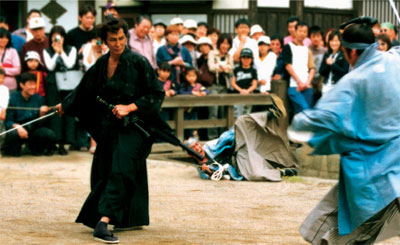
(c) TOEI UZUMASA EIGAMURA
Characters
Among theme parks that feature children's popular fantasy characters are Tokyo Disney Resort and Sanrio Puroland (Tama, Tokyo), widely known for its character Hello Kitty, as well as some "toy kingdoms" (omocha okoku). Unlike other theme parks, sales of unique character goods is the major source of these parks' earnings.
Tokyo Disney Resort
Opened in the city of Urayasu, Chiba prefecture in 1983 as the first Disneyland
outside of the United States, Tokyo Disneyland is situated on 600,000 square
meters of reclaimed land.
In 2001, Tokyo DisneySea was opened, located
next to Tokyo Disneyland, with the seas as its theme. It consists of seven areas,
including Mediterranean harbor and American waterfront. This park, Tokyo Disneyland,
and neighboring hotels and shopping facilities together make up the Tokyo Disney
Resort, which brings in more than 25 million visitors annually.
In addition
to its location near Tokyo and other major cities with huge populations and easy
access to the New Tokyo International Airport in the city of Narita, Chiba prefecture,
Tokyo Disney Resort's great success is also attributable to the fact that --under
the well-known motto "Disneyland will never be completed" (Walt Disney)--
new attractions have been opened one after another, thus winning the support
of many repeat visitors.
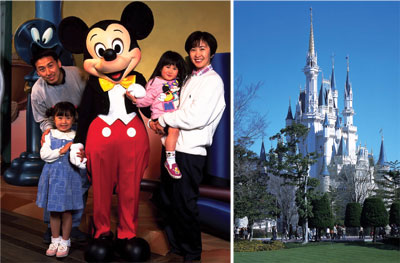
(c) Disney
Sanrio Puroland
This park, which in 2004 celebrated the 30th anniversary of Hello Kitty's birthday, features mainly the attractions that include shows starring Kitty, Cinnamon, My Melody, and other characters. The nearby Tama Center railway stations have Sanrio characters on their information boards outside the stations under the slogan "This Is the Town Where You Can Meet Hello Kitty," promoting the idea of a town where "dreams come true."
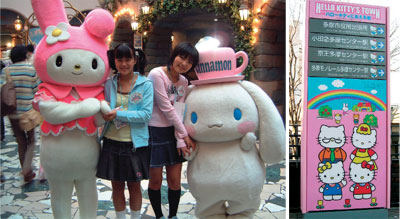
(c) 2006 SANRIO CO., LTD.
Food
Food theme parks are indoor facilities gathering together from around the
country well-known shops serving some particular kind of food. Consisting not
only of specialty shops, they also offer a townscape with a story, or with
some sort of distinctive food-related image, such as "port town" or "the fourth-decade
Showa era" (mid-1950s to mid-1960s). Visitors enjoy menus of noted shops or
restaurants in an out-of-the-ordinary atmosphere. The Yokohama Curry Museum,
for example, recreates a "port town" where the story goes: "This is a town
that thrived as a trading port during the Taisho era, where many people from
other countries come and go, and where hotels and restaurants offer curry and
rice they prepare with unique recipes." Many food theme parks have a museum
showing the history and culture of the featured foods. They also offer various
entertainments, such as playing games and ranking shops according to visitors'
preferences.
The New Yokohama Ramen Museum, opened in 1994, was the first
food theme park in Japan. Food theme parks have steadily increased in number
throughout the country since 2000, and foods, too, have diversified, including
ramen, gyoza, curry, sushi, ice cream, sweets, bread, etc. What is common among
these parks is that their menus are popular among people regardless of gender
and age.
Ikebukuro Gyoza Stadium
A food theme park established in 2002 within the amusement facility, Namja Town, this one is operated by Namco, a video game development company. Selected gyoza shops from across the country gather here in a site reminiscent of an old shopping arcade of the Showa era in its fourth decade (mid-1950s to mid-1960s). What attracts visitors is the nostalgia-evoking atmosphere and the fact that they can eat various types of gyoza all in one place. Namja Town has other theme parks as well, including those specializing in ice cream, cream puffs, and relaxation (e.g., massage) therapies. Namco also operates the Kobe Sweets Harbor, the Yokohama Curry Museum, and many other food theme parks all over the country.
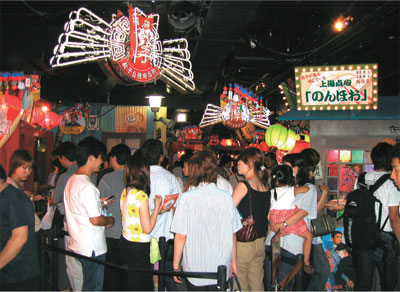
Other Theme Parks
Among notable parks on other themes are Space Camp (an educational space experience facility in Kitakyushu, including a special training program similar to that offered by NASA), Lagunasia (a marine theme park in Gamagori, Aichi prefecture, based on the images of ocean adventure and the Age of Discovery), and Ashikaga Flower Park in Tochigi prefecture.
Bathing facilities with a particular theme
"Spa resorts" (supa rizoto) are large-scale tourist facilities where you can enjoy not only Jacuzzi, sauna, and open-air baths, but also restaurants, beauty care salons, sports gyms, and so on. From the 1980s on, entertainment-oriented spa resorts, which are different from conventional public baths and hot spring inns, have been attracting more and more customers.
Spa Resort Hawaiians
Spa Resort Hawaiians, a large leisure spot in Fukushima prefecture, consists of five theme parks, a hotel, a golf course, and other facilities. Its predecessor was the Joban Hawaiian Center; by adding "spa" to the original theme of "Hawaii" or "southern land" it was renewed and opened in 1990 under the present name. In the Spring Park are a Southern European-style indoor spa with bathing-suit bathing and a huge traditional style bath. There you can enjoy a variety of baths—open-air baths, hinoki cypress-tub bath, utaseyu waterfall bath, Jacuzzi, cold water, etc.
Great Edo Spa Town
A bathing facility visitors can enjoy without staying overnight. Located on Tokyo Bay, its baths are fed by natural hotsprings. Reproducing an Edo-period townscape, it was opened in 2001 and offers an open-air bath, a footbath (see photo), low temperature sauna with rock beds, sand baths, etc. There are also a restaurant, beauty care salon, and other amenities.
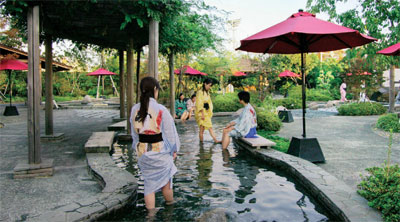
Original text : Takarabako No.08 "Feature" June
2006.
Copyright(C)1997-2008 The Japan Forum. All rights reserved.
Send feedback to forum@tjf.or.jp